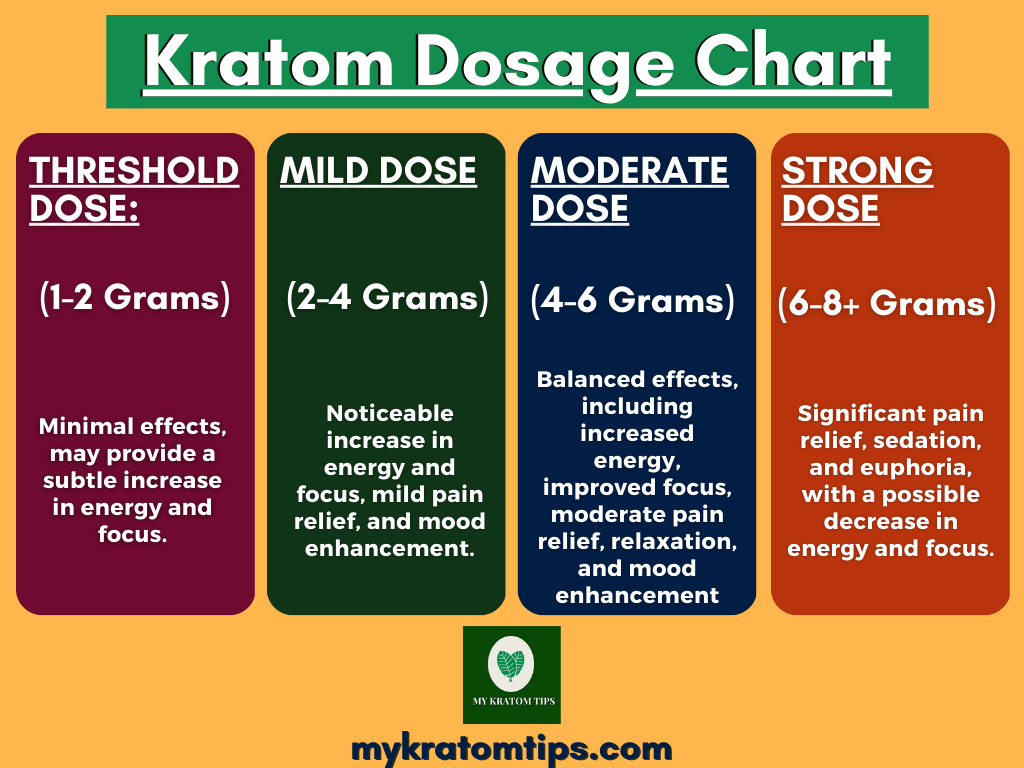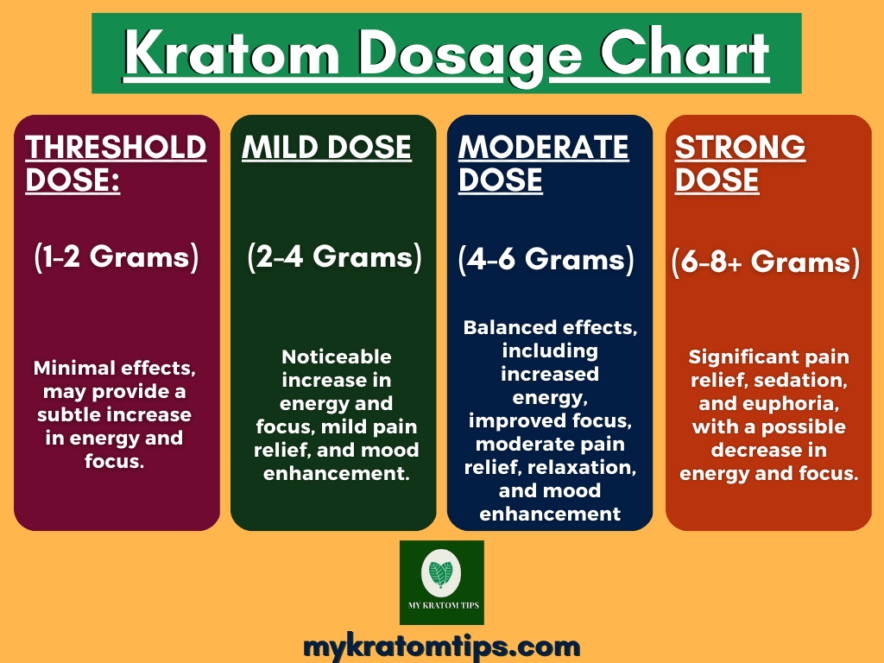Table of Contents
🚨 Medical Disclaimer: The content in this blog post is for informational purposes only and should not be considered as medical advice. Kratom is not FDA-approved for treating opiate withdrawal or any other condition. Always consult a healthcare professional for medical advice and treatment. Use of this information is solely at your own risk. 🚨
Discover the perfect Kratom dosage to successfully detox from opiates. Take control of your recovery journey and find freedom from addiction today.

How Much Kratom to Take to Detox From Opiates
Are you ready to break free from the grip of opiates and find liberation in a natural solution?
Discover the power of Kratom as a detox aid and learn how to determine the right dosage for your journey to recovery.
In this article, we will guide you through the factors to consider, the starting dosage, and the incremental adjustments you may need to make along the way.
Take the first step towards a brighter, opiate-free future with kratom.
Kratom Dosage Guidelines for Opiate Detox
To effectively detox from opiates using kratom, you should follow these dosage guidelines.
It’s important to understand that kratom can vary in potency, so it’s crucial to start with a low dose and gradually increase as needed. For beginners, a dosage of 2-3 grams of kratom powder is recommended. This will allow your body to adjust to the effects of kratom and minimize any potential side effects.
If you find that the initial dose isn’t providing the desired relief, you can gradually increase the dosage by 0.5-1 gram every 30-60 minutes until you reach your desired level of comfort. However, it’s important not to exceed 10 grams of kratom in a single dose, as this can lead to undesirable effects such as nausea and dizziness.
It is also worth noting that everyone’s body is different, and what works for one person may not work for another. It’s recommended to experiment with different dosages to find the optimal amount for your specific needs.
Additionally, it’s advised to consult with a healthcare professional before starting any detox regimen, especially if you’ve any underlying health conditions or are taking other medications.
Remember, the goal of using kratom for opiate detox is to gradually reduce your reliance on opiates, so it’s important to use kratom responsibly and in moderation.
Liberation from opiates is possible, and following these dosage guidelines can help you on your path towards freedom and recovery.
Factors to Consider When Determining Kratom Dosage for Opiate Detox
You should consider various factors when determining the appropriate dosage of kratom for opiate detox. The dosage of kratom that works best for one person may not be the same for another. It’s important to take into account factors such as your body weight, tolerance level, and the severity of your opiate addiction.
Typically, a moderate dose of kratom for opiate detox is around 2-5 grams. However, it’s advisable to start with a lower dose and gradually increase it if needed. This allows you to assess how your body responds to kratom and helps avoid any potential side effects.
Additionally, the strain of kratom you choose can also impact the dosage. Red vein strains are generally recommended for opiate detox as they provide a calming and pain-relieving effect. Green and white vein strains are often considered more stimulating and may require a lower dosage.
Always remember to stay hydrated and listen to your body. If you experience any adverse effects, such as nausea or dizziness, it may be a sign that you’ve taken too high of a dose. Adjust accordingly and consult a healthcare professional if necessary.
In conclusion, determining the appropriate dosage of kratom for opiate detox requires considering factors such as body weight, tolerance level, addiction severity, strain of kratom, and individual response. It’s essential to start with a lower dose and gradually increase it while closely monitoring your body’s reaction.
Liberation from opiates is possible, and finding the right kratom dosage can be a significant step towards achieving it.
Starting Kratom Dosage for Opiate Detox: Finding the Right Balance
When starting your kratom dosage for opiate detox, it’s crucial to find the right balance. This means determining the most effective initial dosage that will help alleviate withdrawal symptoms without overpowering the effects of opiates.
Effective Initial Kratom Dosage
Finding the right initial dosage of kratom is crucial for an effective detox from opiates. It is important to start with a moderate dose and gradually adjust it based on your body’s response. Here is a table that outlines the recommended dosage range for beginners:
| Dosage Level | Kratom Amount |
|---|---|
| Low | 1-2 grams |
| Moderate | 2-4 grams |
| High | 4-6 grams |
| Very High | 6-8 grams |
Starting with a low or moderate dosage is recommended, as it allows you to assess your tolerance and adjust accordingly. Remember to consider factors such as body weight, metabolism, and opiate usage history when determining your initial kratom dosage.
It is important to find the right balance to effectively manage opiate withdrawal symptoms while avoiding potential side effects. Always consult with a healthcare professional or a knowledgeable kratom vendor for personalized guidance in your journey towards liberation from opiates.
Balancing Kratom and Opiates
Balancing the use of kratom and opiates can be challenging, but it’s important to find the right combination that effectively manages your symptoms. Kratom, a natural herb, has gained popularity as an alternative to traditional opiates for pain management and opiate withdrawal. However, using both substances together requires caution and careful monitoring.
Here are three key considerations for finding the right balance:
- Start with low doses: Begin with a low dose of kratom and gradually increase it until you achieve the desired relief. This approach helps minimize the risk of adverse effects and allows you to gauge the effectiveness of kratom.
- Keep track of your symptoms: Maintain a symptom journal to monitor how both kratom and opiates affect your pain levels, cravings, and overall well-being. This record will help you make informed decisions about adjusting your dosage.
- Seek professional guidance: Consult with a healthcare professional experienced in kratom and opiate management. They can provide personalized advice, monitor your progress, and ensure your safety throughout the process.
Finding the right balance between kratom and opiates is crucial to effectively managing your symptoms while on your journey to liberation from opioids. Remember, everyone’s experience is unique, so it’s essential to listen to your body and work closely with a healthcare professional who can guide you towards the best combination for your individual needs.
Optimal Detoxification With Kratom
To effectively detoxify, you should gradually decrease your opiate intake while incorporating kratom into your regimen under the guidance of a healthcare professional.
Detoxification from opiates can be challenging, but with the right approach, you can find liberation from their grasp. It’s important to work closely with a healthcare professional who understands the complexities of opiate withdrawal and can provide personalized guidance.
When incorporating kratom into your detoxification plan, it’s crucial to start with a low dose and gradually increase it as needed. While there’s no one-size-fits-all dosage, starting with 2-3 grams of kratom powder or 1-2 kratom capsules is generally recommended. However, it’s important to remember that each individual’s response to kratom may vary, so regular monitoring and adjustments are necessary.
Increasing Kratom Dosage for Opiate Detox: When and How to Adjust
You should start considering increasing your kratom dosage for opiate detox when you experience withdrawal symptoms that aren’t adequately relieved. As you take steps towards liberation from opiates, it’s important to understand how to adjust your kratom dosage effectively.
Here are a few key points to consider:
- Monitor your symptoms: Pay close attention to the severity and duration of your withdrawal symptoms. If they persist or worsen despite your current kratom dosage, it may be time to increase it.
- Consult a knowledgeable source: Reach out to a trusted kratom expert or healthcare professional who can guide you in adjusting your dosage. They can provide personalized advice based on your specific needs and circumstances.
- Start with small increments: When increasing your kratom dosage, it’s essential to do so gradually. Begin by adding a small amount, such as 0.5 grams, to your current dose. Monitor how your body responds before making any further adjustments.
Kratom Dosage Schedule for Opiate Detox: Daily Recommendations
Now that you understand how to adjust your kratom dosage for opiate detox, let’s delve into the daily recommendations for a kratom dosage schedule.
It’s important to note that everyone’s body is unique, so finding the right dosage may require some trial and error. However, these recommendations can serve as a starting point on your journey to liberation from opiates.
For beginners, it’s generally recommended to start with a low kratom dosage of 1-2 grams per day. This allows your body to adjust to the effects of kratom gradually. After a few days, if you feel that the effects aren’t strong enough, you can increase your dosage by 0.5 grams each day until you find the optimal dose that alleviates your opiate withdrawal symptoms.
Once you’ve found your ideal dosage, it’s important to maintain consistency. Taking kratom at the same time each day can help regulate its effects and ensure that you receive the maximum benefit. However, it’s important to remember not to exceed the recommended dosage, as taking too much kratom can lead to unwanted side effects.
By following a daily kratom dosage schedule, you can effectively manage opiate withdrawal symptoms and work towards achieving freedom from addiction. Remember to always listen to your body and consult with a healthcare professional if you have any concerns or questions.
Your journey to liberation starts with finding the right dosage for you.
Monitoring and Adjusting Kratom Dosage for Opiate Detox: Tips for Success
When it comes to monitoring and adjusting your kratom dosage for opiate detox, there are a few tips for success that can help you along the way.
It’s important to find the right dosage that effectively manages your withdrawal symptoms without causing any adverse effects.
Additionally, you may need to make adjustments to your dosage over time as your body adapts to the kratom.
Effective Dosage Strategies
Finding the right dosage of kratom is crucial for an effective detox from opiates. When using kratom for opiate detox, it’s important to follow a strategic dosage plan to achieve the desired results. Here are three effective dosage strategies to consider:
- Start low and gradually increase: Begin with a low dosage, around 2 to 3 grams of kratom powder. Monitor how your body responds and gradually increase the dosage if needed. This approach allows you to find the minimum effective dose for your body.
- Find the sweet spot: Experiment with different dosage ranges, typically between 4 to 6 grams, to find your ‘sweet spot’ where you experience the desired effects without any adverse side effects. This dosage will vary from person to person, so it’s essential to listen to your body.
- Rotate strains: To prevent tolerance and maintain the effectiveness of kratom, rotate between different strains. This strategy can enhance the detox process and optimize your results.
Managing Withdrawal Symptoms
To effectively manage withdrawal symptoms, it’s crucial to prioritize self-care and seek support from healthcare professionals or support groups.
Withdrawal from opiates can be a challenging and uncomfortable process, but there are strategies you can implement to help alleviate the symptoms.
First and foremost, take care of yourself physically and emotionally. Ensure you’re getting enough rest, eating healthy meals, and staying hydrated. Engage in activities that promote relaxation and reduce stress, such as meditation or deep breathing exercises.
Additionally, consider reaching out to healthcare professionals or support groups for guidance and encouragement. They can provide valuable resources, advice, and the understanding you need during this challenging time.
Long-Term Detox Maintenance
You may want to consider exploring long-term maintenance options for managing withdrawal symptoms and preventing relapse. When it comes to detoxing from opiates, it’s important to have a plan in place to ensure long-term success.
Here are three key options to consider:
- Medication-assisted treatment (MAT): This approach combines medication, such as buprenorphine or methadone, with counseling and behavioral therapies. MAT can help reduce cravings and withdrawal symptoms, increasing chances of successful detox and long-term recovery.
- Support groups: Joining a support group, such as Narcotics Anonymous or SMART Recovery, can provide a valuable network of individuals who’ve experienced similar challenges. Sharing your struggles and successes with others can help you stay motivated and accountable throughout your detox journey.
- Therapy and counseling: Seeking professional therapy and counseling can provide you with the tools and coping strategies needed to manage cravings and prevent relapse. A therapist can help you address underlying issues that may have contributed to your opioid use and provide guidance on developing a healthy and fulfilling life without substances.
By considering these long-term maintenance options, you can increase your chances of a successful detox and enjoy a life free from the grip of opiates.
Tapering Off Kratom Dosage After Opiate Detox: Gradual Reduction Techniques
If you’re ready to taper off your kratom dosage after completing an opiate detox, there are gradual reduction techniques that can help you ease off the substance. Tapering off kratom is a safe and effective way to minimize withdrawal symptoms and allow your body to adjust to lower doses. By gradually reducing your kratom intake, you give your body time to adapt and minimize any potential discomfort.
To start tapering off your kratom dosage, it’s important to establish a plan. Begin by setting a reduction schedule that suits your needs and goals. You can start by reducing your daily intake by 10-20% every week or every few days, depending on how you feel. It’s crucial to listen to your body and adjust the tapering speed accordingly.
During the tapering process, it might be helpful to keep a journal to track your progress and any withdrawal symptoms you may experience. This can help you identify patterns and make necessary adjustments to your tapering plan.
In addition to gradual reduction, there are other techniques that can aid in the process. These include staying well-hydrated, getting regular exercise, and practicing stress-reducing activities such as meditation or yoga.
Frequently Asked Questions
Can Kratom Be Used as a Standalone Treatment for Opiate Detox, or Should It Be Combined With Other Therapies?
Kratom can be used as a standalone treatment for opiate detox, but combining it with other therapies may enhance the detox process. It’s important to consult with a healthcare professional to determine the most effective approach for your situation.
Are There Any Potential Side Effects or Risks Associated With Using Kratom for Opiate Detox?
When using kratom for opiate detox, it’s important to be aware of potential side effects and risks. These may include nausea, constipation, dizziness, and dependency. It’s best to consult with a healthcare professional for guidance.
How Long Does It Typically Take for Kratom to Start Alleviating Withdrawal Symptoms During Opiate Detox?
Typically, it takes around 30 minutes for kratom to start alleviating withdrawal symptoms during opiate detox. It’s important to find the right dosage for you, as taking too much can lead to adverse effects.
Is It Possible to Become Dependent on Kratom While Using It for Opiate Detox, and if So, How Can This Be Managed?
Yes, it is possible to become dependent on kratom while using it for opiate detox. To manage this, gradually reduce your kratom dosage over time and seek support from a healthcare professional.
Are There Any Specific Guidelines or Recommendations for Using Kratom for Opiate Detox in Individuals With Pre-Existing Medical Conditions or Who Are Taking Other Medications?
If you have pre-existing medical conditions or are taking other medications, it’s important to consult with a healthcare professional before using kratom for opiate detox. They can provide specific guidelines and recommendations tailored to your individual needs.
Conclusion
In conclusion, finding the appropriate kratom dosage for opiate detox requires careful consideration and monitoring. Adjusting the dosage as needed and following a recommended schedule can help ensure success.
Gradually reducing the kratom dosage after detox is also important for a smooth transition.
By following these guidelines and techniques, individuals can effectively use kratom as a tool in their journey towards opiate detoxification.







